The Panasonic Lumix DMC LX7 is a little known camera simply because it didn’t ship out of the house of Canon or Nikon. What is little known about this camera is that it not only sports a Leica lens, but also the fastest lens in a point and shoot camera. With a maximum aperture of f/1.4-2.3, there isn�t a situation that the LX7 technically can’t handle. It also boasts of a burst speed of 11 fps and an incredible video bitrate of 28 Mbps. But do the impressive numbers translate into impressive quality? We find out.
Well, we got a hold of the LX7 and put it through a rigorous test routine, and by that we mean giving our DSLR a break and making the Panasonic Lumix DMC LX7 our primary camera. Does it live up to the task? Well, read on to find out.
Build & Ergonomics
The first thing you should know about the Panasonic Lumix DMC LX7 is that it is one deceptive piece of work. It is rather compact for a camera with such impressive optics, but if you’re looking for something that you could just slip into your pockets and forget about, this is not that camera. Even though the body itself is quite slim, the lens design causes the assembly to protrude quite noticeably out the front. This is probably to accommodate a real-time aperture ring along with an aspect ratio switch right on the front. There’s even a focus selection switch that toggles the AF between Macro, regular and manual modes. Three controls at the finger-tip, we like it.
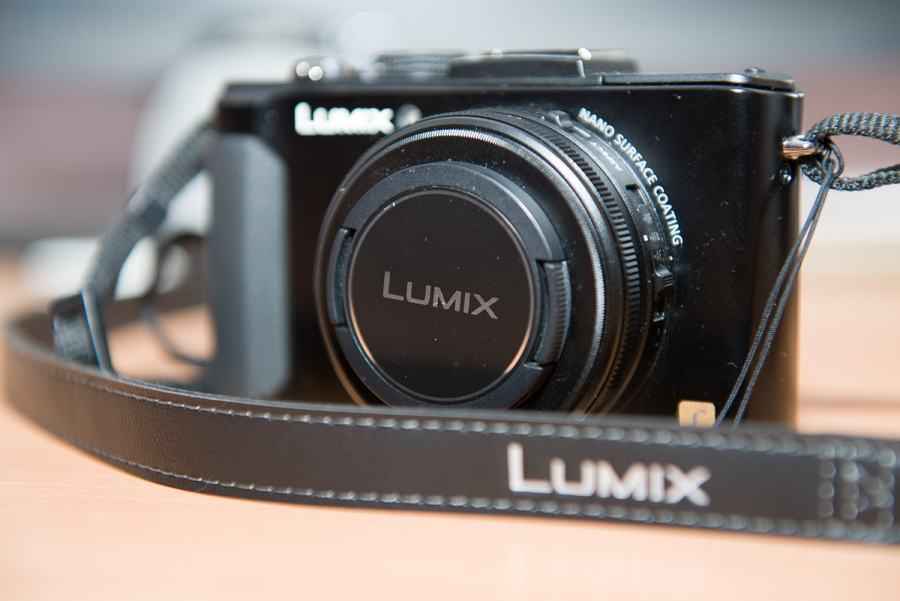 |
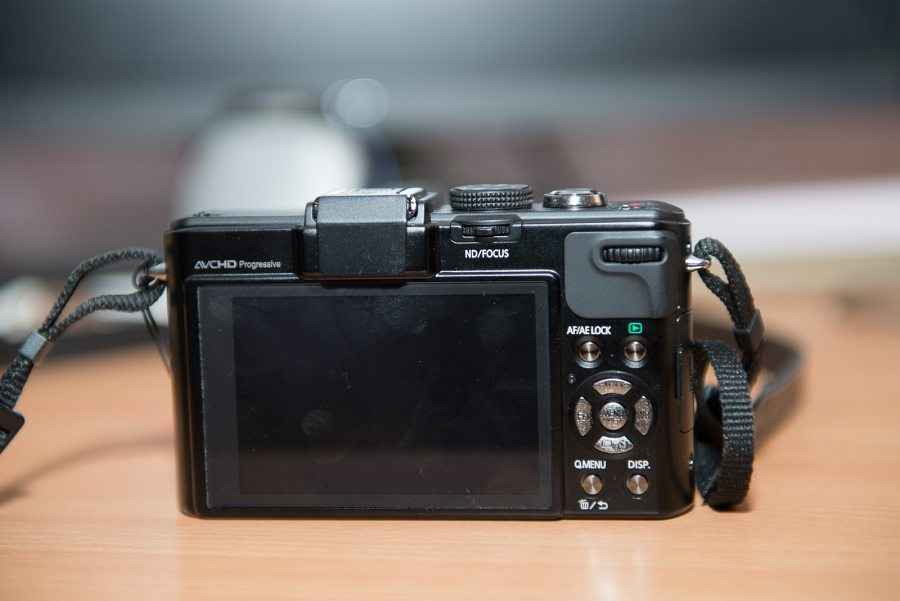 |
The ergonomics on the Panasonic Lumix DMC LX7 are based on a very simple point and shoot design, so besides the unique lens ergonomics, everything else is pretty standard. The back has the usual circle of four buttons with one in the middle that takes care of such as ISO, White Balance, Drive mode etc. What we liked was the light horizontal jog dial on the back that is perfect for operating with the thumb. Panasonic added a nifty little toggle for ND filter, which comes in rather handy when trying to shoot at f/1.4 in broad daylight. The toggles and dials work beautifully, however, we can’t really say the same about the build of the buttons. A lot of the times, we couldn’t register enough feedback from the buttons to know whether they registered our press or not.
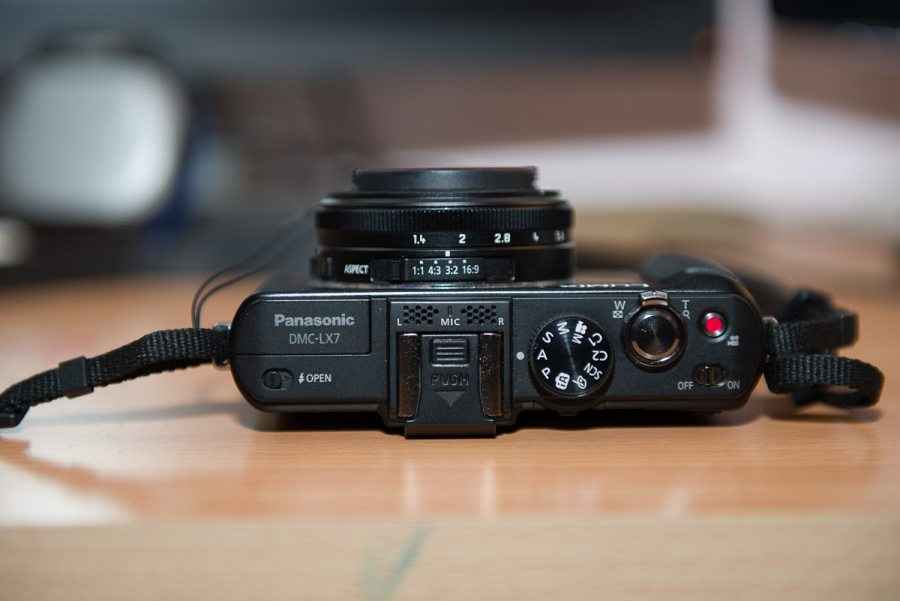 |
 |
As far as the build goes, the lens on the Panasonic Lumix DMC LX7 is Leica-made and the rest of the body is made of solid plastic with metal reinforcements in parts. We wouldn’t be too concerned about babying this camera, especially given that it takes care of our primary concern, the front element of the lens. The Leica glass comes with a lens cap which must be removed prior to operation. In fact, if the lens cap is still on, the camera will not power up, which is in some respects annoying, but we understand the thought behind this feature. Another design feature we really like is the physical on/off toggle. Normally one would find a tiny button on top that would either bring the camera to life or put it to rest, but Panasonic has always preferred using a left/right switch for the purpose. There is also a hot shoe on the camera, in front of which is placed a stereo microphone. In what we consider a very unique design call, Panasonic has included a proprietary port of sorts right above the rear LCD which serves as a connection point for an electronic viewfinder accessory.
 |
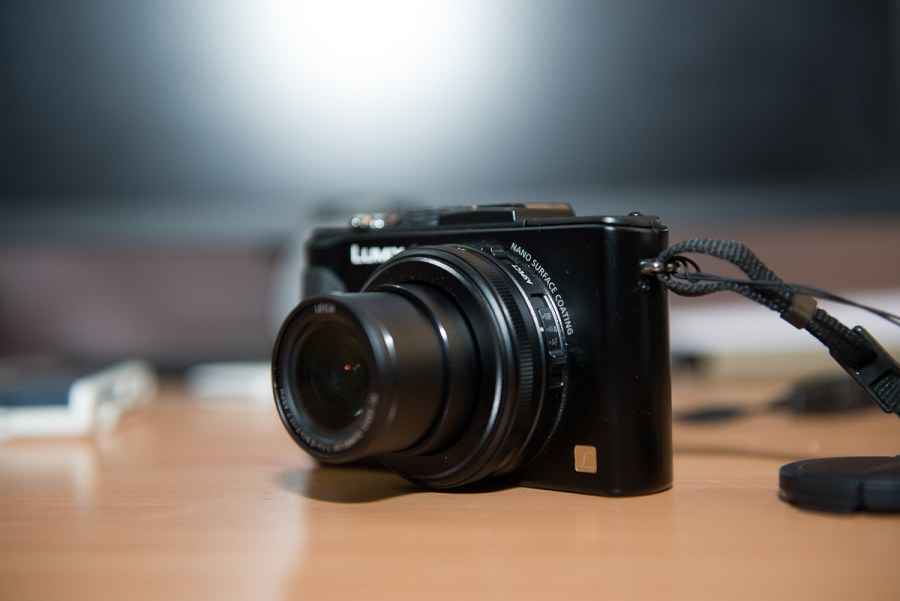 |
Overall, the build and design of the Panasonic Lumix DMC LX7 feel very premium, despite the fact that the front of the camera is entirely made of plastic. The aperture ring along with the focus and aspect ratio toggles are quite good, with clicks that register very distinctively.
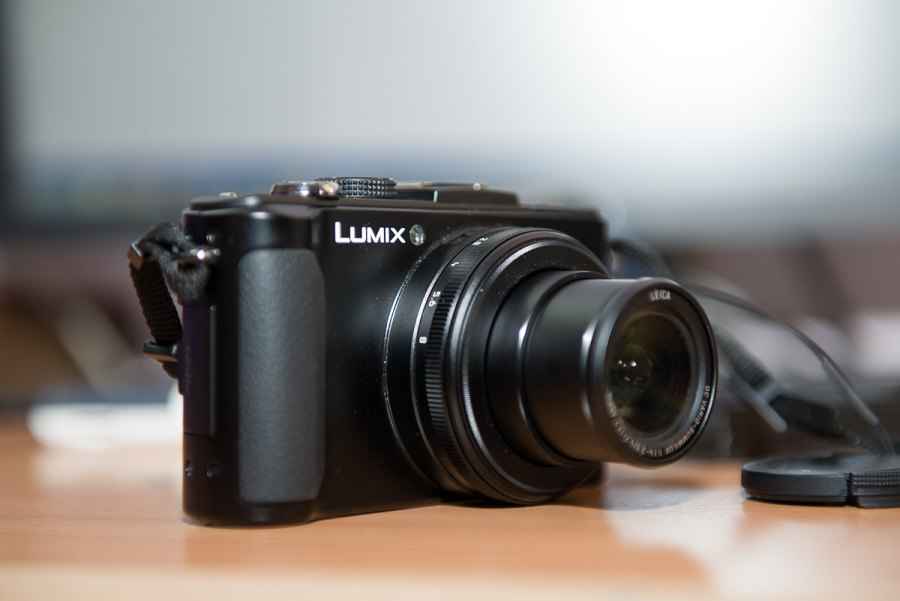 |
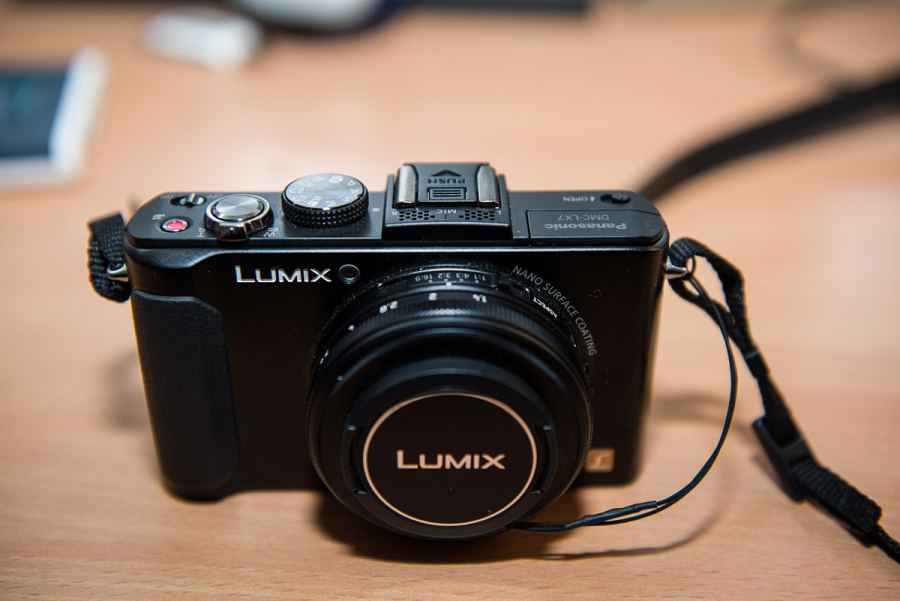 |
Features
The Panasonic Lumix DMC LX7comes with a very modest set of features, including a 10.1 megapixel CMOS sensor complemented with Panasonic’s Venus Engine image processing chip. The pixel count is somewhat on the lower side, and the sensor dated, given how most cameras in this category have at least a 12 million pixels on a Back-Side Illuminated (BSI) sensor. The lower pixel count does help the sensor keep noise levels low, but we would have loved to see at least a BSI sensor in here.
While the sensor may leave a little more to be desired, the Leica lens more than makes up for it. The Panasonic Lumix DMC LX7 takes advantage of the Leica tie-up that Panasonic has in place. The Leica branded 24-90mm lens on the LX7 boasts of the fastest aperture range in this segment, with a very impressive f/1.4-2.3 range. The closest competitor the Panasonic Lumix DMC LX7 has is the Samsung EX2F, which is not only short by 10mm on the telephoto end and has an aperture range of f/1.4-2.7 – it is also not available in India.
Other features on the Panasonic Lumix DMC LX7 include full HD video recording at 60 fps with stereo microphones (the LX5 only did 720p video) and a host of scene modes for shooting stills. Did we mention that the LX7 can shoot full resolution RAW files at a blazing 11 fps?
Visit page two to check out the Panasonic Lumix DMC LX7's Image and Video Performance, and Verdict…
Image Performance
We are of the opinion that features and numbers are only one side of the coin. At the end of the day, what matters is how well all the gimmicks come together to give you an image which you will either look at and love, or you will look at and wonder why you ever bought the camera that you did.
So, when we heard about the really fast apertures on the Panasonic Lumix DMC LX7, we did feel it was too good to be true.
We put the LX7 through a battery of shooting situations. Like we said earlier, it became our DSLR replacement for the duration of this test and we found that there is as much to love about this tiny little thing as there is to hate about it.
-small.jpg) |
-small.jpg) |
-small.jpg) |
-small.jpg) |
To begin with the good, the macro mode on the Panasonic Lumix DMC LX7 is just astounding. With a minimum focusing distance of just 1cm at the wide end, the macro shots out of the LX7 do tend to take on DSLR like qualities, especially when you shoot at f/2.8 or below. The images are quite rich in detail and the colors just pop. We found that in macro mode, the focusing was also very quick, with the camera giving priority to the center of the frame, but that is nothing new. If you’re looking to get creative with your compositions, we recommend the age old method of focus-recompose. As long as you don’t move your camera too much, the subject should remain in focus, mostly thanks to the large-ish depth of field provided by the small sensor.
We love just how sharp the Leica lens is. Leica has a reputation for itself when it comes to lenses, and Panasonic is capitalizing on it to the fullest. The Panasonic Lumix DMC LX7’s lens is as sharp as far as lenses go in a point and shoot and though it won’t compete with the DSLR variants, the lens is still visibly sharp enough to leave most of the competition eating dust.
There are a few things about the Panasonic Lumix DMC LX7 that left us sorely disappointed though. For starters, the LX7 is terrible when it comes to auto white balancing shots. We went out for lunch to one of our favorite establishments and turns out they love using incandescent bulbs to light up their jolly establishment. On auto white balance, the LX7 rendered images with a severe orange cast. When we tried to correct the white balance on the image by using a white reference point, we were still left with a pretty noticeable pink cast on our subject’s face. The pink cast had to be separately be taken care of by reducing the intensity of the red saturation, something that’s not so hard if you’re using Adobe Lightroom. However, if you’re just an ordinary person who wants to take awesome shots without having to worry about editing, the LX7 will sorely disappoint. We even tried using the incandescent preset on the camera for white balance, but even then our images were a little too warm.
-small.jpg) |
-small.jpg) |
-small.jpg) |
-small.jpg) |
The second thing that we found just down right frustrating about the Panasonic Lumix DMC LX7 is its focusing system. The LX7 has four focusing modes that work in either full AF or Macro AF range. The four modes are Face Recognition, Multiple Area, User Area Select and AF tracking. While shooting in full AF and Multiple Area mode selected, we often found that the LX7 refused to lock focus on distant subjects irrespective of the amount of light in the room. This was not a general trend though, only an intermittent problem that seemingly arose every now and then for no apparent reason, which is why it’s so frustrating. We did notice that the Panasonic Lumix DMC LX7’s AF problem was only limited to the multiple-area mode as the other three worked like a charm as long as we worked within the limits of the optics. The AF is generally pretty quick, but at times the lens cycles through its entire focusing distance before locking on, which could potentially lead to a delay in taking the shot. However, one must keep in mind that the LX7 is after all a point and shoot camera, so expecting focus speeds that rival the DSLR lenses is sort of unfair.
Another thing we found to be a major headache was the menu system on the Panasonic Lumix DMC LX7. While most camera makers have managed to refine their menu system over the years, it would seem the Panasonic has chosen to completely ignore this one aspect. The menu system seems to be archaic at best, with all options just crammed under one tab. There are six sub-tabs under camera settings and sevend under camera setup and cycling through them can be quite a pain. We feel that the options could be better organized.
-small.jpg) |
-small.jpg) |
-small.jpg) |
-small.jpg) |
We did save the best for the last. What really did surprise us about the Panasonic Lumix DMC LX7 was its dynamic range. When shooting backlit subjects in aperture priority mode, the camera exposed for the subject, and not the huge window behind the subject that was lighting up the whole room. We’re almost always used to seeing the subject turn into a silhouette when backlighting is involved, but the Panasonic LX7 manages to retain an excellent amount of dynamic range. While dynamic range is one part of the equation, what it also does is give priority to the subject with respect to metering so as to make sure that it’s always the subject that shows up properly exposed.
Video Performance
The movie mode on the Panasonic Lumix DMC LX7 is also quite something. The camera is capable of recording in 1920×1080 resolution at 60 frames per second with stereo sound using the AVCHD Progressive codec. The resulting file has a bitrate of a whopping 28Mbps, which is higher than the 25Mbps that most conventional DSLRs offer. In fact, Panasonic has the reputation of delivering some pretty ridiculous bitrates in its cameras, like the DMC-GH3, the camera that can record video at 72 Mbps encoding, which matches broadcast quality.
So, if you’re planning on maximizing the video potential of the LX7, you better purchase a fast card, like the Sandisk 64GB Extreme Pro which has a write speed of 95MB/s. These cards are fast enough to not only gobble up the gargantuan video files with ease, but it will also make sure that you can maximize the 11fps burst mode by not getting bottlenecked due to slow write speeds. The video quality itself is quite good, and surprisingly good for a point and shoot camera.
Conclusion
The Panasonic Lumix DMC LX7 is one hell of a camera. The fast aperture Leica lens is incredibly sharp and the small 1/1.7” sensor coupled with the Venus Engine does manage to spit out images with pleasing colors and a good contrast. What it does lack however is the ability to remain noise free at high ISOs, which becomes evident at ISO 3200 and above. The focus, when it locks on, is almost always accurate and reasonably fast. If you couple this camera up with a fast card like we did, then you can even take advantage of the 11 fps shooting speed along with making stunning videos at a very high resolution.
However, the camera does lose out on the fact that the focusing on the LX7 is quite moody, sometimes not locking onto a subject. Then there is the frustrating menu system and the slightly toy-like buttons on the back. As great as the images and video out of the LX7 may be, due to these few drawbacks, the camera leaves a little more to be desired. However, if you’re patient and can overlook the silly menu and work with the AF, then we don’t see why you shouldn’t go for this camera. At the end of the day, Leica glass is Leica glass.
Swapnil Mathur
Swapnil was Digit's resident camera nerd, (un)official product photographer and the Reviews Editor. Swapnil has moved-on to newer challenges. For any communication related to his stories, please mail us using the email id given here. View Full Profile
